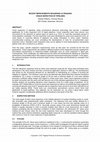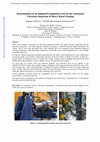Papers by Herbert Willems

Nondestructive Characterization of Materials II, 1987
Results of ultrasonic velocity measurements on creep tested specimens of austenitic Alloy 800H ar... more Results of ultrasonic velocity measurements on creep tested specimens of austenitic Alloy 800H are presented. It is shown that different influences have to be taken into account in order to correctly describe the observed behavior of the velocity during creep. At high stresses resulting in short lifetimes, the measured velocity changes can be attributed mainly to the plastic deformation of the material whereas at lower stresses the influence of physical discontinuities (micropores, micro-cracks) becomes dominant. Additionally, a purely thermal ageing effect due to carbide precipitations is noticed. Damage patterns are demonstrated using microradiography as well as metallography. From the results obtained it is suggested that the ultrasonic velocity becomes sensitive to microstructural damage at the transition range from secondary to tertiary creep. Concerning practical applications, this could allow the nondestructive detection of creep damage at a relatively early stage.
The invention relates to a device for testing of ferromagnetic materials, SUCH AS PIPES TUBULAR O... more The invention relates to a device for testing of ferromagnetic materials, SUCH AS PIPES TUBULAR OR OTHERWISE, WITH RESPECT TO BUGS, CRACKS, CORROSION OR OTHERWISE, with at least one current pulse HIGH FREQUENCY SERVING FOR APPLICATION IN UNION WITH A mAGNETIC FIELD IN THE DRIVE AND / OR DETECTION BY WAVES OF uLTRASOUND IN THE WALLS OF MATERIAL and an ultrasonic transducer ELECTROMAGNETICOS configured in the system MAGNETICO GENERATING THE mAGNETIC FIELD, characterized in such a way that the converter uLTRASOUND AVAILABLE AREA BETWEEN THE POLAR different polarities of a provision MAGNETICA FURTHER, THAT GENERATED MATERIAL ON THE WALLS OF A MAGNETIC FIELD PREVIEW.

Crack inspection of pipelines using conventional ultrasonic technology has become a standard appl... more Crack inspection of pipelines using conventional ultrasonic technology has become a standard application for in-line inspection (ILI) of liquid pipelines. Crack inspection tools have proven very successful for the detection of various types of cracks (e.g. SCC) or crack-like anomalies present in many pipelines worldwide. The first inspection tools were developed for axial crack inspection (UC), as most cracks or crack-like defects in pipelines are axially orientated. In some cases, however, circumferential cracking can occur prompting the development of tools for circumferential crack inspection (UCc). Standard crack inspection tools can be applied in most liquid pipelines transporting typical crude oils or products (e.g. diesel). Over the years, specific inspection requirements came up that were not covered by the first tool generations. These requirements are related to different aspects of the inspection process ranging from tool-related characteristics to inspection-related chal...
MRS Proceedings, 1988
Residual lifetime analysis of power plant components requires information on the degree of degrad... more Residual lifetime analysis of power plant components requires information on the degree of degradation of the material. In case of hightemperature creep, material damage can be related to cavity formation or to the accumulated creep strain. At present, only metallographic replication technique is widely used for in-service inspection to detect creep cavitation. Other NDT-techniques like ultrasonic velocity and electrical resistivity, which have potential for detection of low pore concentrations, are being developed for practical application. The use of capacitive strain gages yields encouraging results for the long-time monitoring of creep deformation. Potential and limits of these NDT-techniques together with industrial needs for creep damage assessment are reviewed.

Nondestructive Characterization of Materials VI, 1994
During the interim storage of spent fuel rods the verification of the identity as well as of the ... more During the interim storage of spent fuel rods the verification of the identity as well as of the integrity of special shielding casks containing final disposal packages has to be guaranteed by applying appropriate safeguards measures over a period of up to 50 years until a geological repository goes into operation. The casks to be verified are made of cast iron (GGG 40) and consist of the actual final disposal package and a cylindrical shielding cask with a height of about 6 m and a diameter of about 1.5 m which is closed with a screwed-on lid. It is planned to link the lid to the cask by a short weld seam, so that the lid can only be removed by destroying the weld. The identification of the weld allows for statements on the integrity of the cask as well as on its identity. The latter is, in addition, supported by non-reproducible cask characteristics.
Nondestructive Characterization of Materials II, 1987
Ultrasonic techniques as well as electrical resistivity measurements were applied to assess the d... more Ultrasonic techniques as well as electrical resistivity measurements were applied to assess the degree of creep damage in 14 MoV 6 3 steel (0.5 Cr, 0.5 Mo, 0.25 V), Samples were cut from a tube bend which had failed after 130,000 h/535°C service exposure providing us with a complete variety of damage states. Using metallographic methods the microstructural damage was classified in terms of micropore concentration and microcrack formation, respectively. The actual porosity of the material was determined quantitatively by density measurements.

2010 8th International Pipeline Conference, Volume 1, 2010
The two prevailing technologies in in-line inspection (ILI) of pipelines used for metal loss dete... more The two prevailing technologies in in-line inspection (ILI) of pipelines used for metal loss detection are magnetic flux leakage (MFL) and ultrasonic testing (UT). The ultrasonic method provides a more precise depth sizing as a direct measurement of the remaining thickness of the pipe wall is obtained. The advantage of providing more precise defect data leads, in turn, to a more accurate and reliable defect assessment thus reducing follow-up costs for the pipeline operator. As conventional ultrasonic tools, which are based on piezoelectric transducers, require a liquid coupling medium to couple the ultrasonic energy into the pipe wall, this technology is readily applicable to the majority of liquids pipelines, but not to gas pipelines (unless a batch of liquid is used). In order to apply ultrasonic ILI technology for metal loss inspection to gas pipelines directly, a new tool was developed based on the EMAT (electro-magnetic acoustic transducer) principle by which ultrasound is gene...

Der durch zerstörungsfreie Prüfverfahren geleistete Beitrag zur Qualitätssicherung befindet sich ... more Der durch zerstörungsfreie Prüfverfahren geleistete Beitrag zur Qualitätssicherung befindet sich im Spannungsfeld zwischen zusätzlichen Kosten bei Herstellung und Betrieb und der erzielbaren Zuverlässigkeit in der Qualitätsaussage. Die Prüfverfahren müssen daher angesichts eines in den letzten Jahren steigenden Kosten und Zeitdrucks im Sinne der Wettbewerbsfähigkeit nicht nur schneller und preisgünstiger, sondern gleichzeitig auch noch zuverlässiger werden. Dieser Hintergrund bringt es mit sich, dass auch bestehende ZfP-Normen und -Regelwerke in der Folge dieses Trends einer Anpassung und exakteren Beschreibung der Prüftechnik bedürfen. Auch für große Schmiedestücke, die beispielsweise für Turbinen- und Generatorrotoren im Energiemaschinenbau eingesetzt werden, sind in den vergangenen Jahren die Qualitätsanforderungen stetig angestiegen. Hierdurch ist ein beständig wachsender Anteil an großvolumigen Schmiedestücken zu verzeichnen, die mittels Ultraschall automatisiert zu prüfen sind...

Große Schmiedestücke für Turbinen- und Generatorrotoren sind durch eine sehr geringe Schwächung d... more Große Schmiedestücke für Turbinen- und Generatorrotoren sind durch eine sehr geringe Schwächung des Ultraschalls gekennzeichnet. Aufgrund von „Phantomanzeigen“ sind oft nur geringe Impulsfolgefrequenzen möglich. Daher beeinflusst der Abstand der Prüfpunkte in Scan- und Indexrichtung (Prüfraster) bei der automatisierten Ultraschallprüfung großer Schmiedestücke wesentlich die Prüfzeit und damit die Prüfkosten. Das Prüfraster muss deshalb zwischen Hersteller und Besteller vereinbart werden. Da die geltenden Normen und anderen Regelwerke dazu keine eindeutigen Vorgaben machen bzw. sogar zu Abtastlücken mit ungenügender Prüfempfindlichkeit führen können, wurde vom Unterausschuss Automatisierte Prüfsysteme des DGZfP Fachausschusses Ultraschall eine Richtlinie zur Festlegung des Prüfrasters für eine vollständige (100%) Volumenprüfung erstellt. Durch die Einführung einer normierten Rastergüte Rn ergeben sich Randbedingungen für eine lückenfreie und mehrfach überlappende Abtastung. Weiterhin...

Heavy rotor forgings, in particular for the power generation market, are highly stressed componen... more Heavy rotor forgings, in particular for the power generation market, are highly stressed components and the ultrasonic inspection is the most important method to guarantee a sufficient material quality throughout the volume. This is why more and more heavy rotor forgings have to be inspected using automated inspection systems guarantying a high probability of detection for possible flaws, good documentation as well as highly repeatable inspection. In contrast to manual inspection, automated inspection does not allow for an optimization of a flaw reflection by moving the probe, as the probe is continuously moved over the part surface in distinct scan lines, resulting in a distinct pattern of inspection points. To ensure full volume coverage using overlapping ultrasonic beams from neighboring inspection points, a precise definition of an examination grid is required. To assure that all critical errors are detected, multiple scan directions have to be applied as per VGB-R 504 M [1] to ...

Volume 2: Pipeline Integrity Management, 2012
Crack inspection of pipelines using liquid-coupled ultrasonic technology has established itself a... more Crack inspection of pipelines using liquid-coupled ultrasonic technology has established itself as an accepted ILI (in-line inspection) technology that is routinely applied by many operators. The inspection is based on the pulse-echo technique using 45° shear waves which provide very good detection sensitivity. While length sizing of cracks is reasonably precise, the accuracy of (amplitude-based) depth sizing is limited to some extent. Apart from the crack size, the methods applied for crack assessment have to take into account the geometry of the actual pipe, the relevant material properties and the loading conditions. The work presented is based on the FAD method (Failure Assessment Diagram) being the most common technique for assessment of crack-like defects in pipes. It is shown how the assessment results depend on the quantities determined by ILI (e.g. crack size, wall thickness) and their associated measurement uncertainties. Using a deterministic approach the sensitivity with...
Materials Testing, 2013
Abstract Die Gefährdung durch Pipelines ist in der Öffentlichkeit wegen zahlreicher Berichte über... more Abstract Die Gefährdung durch Pipelines ist in der Öffentlichkeit wegen zahlreicher Berichte über Unfälle weitgehend präsent. Warum? Weil jeder Unfall die Gefahr von massiven Umweltschäden mit sich bringt und bei Leitungen, die durch besiedeltes Gebiet führen, sogar mit menschlichen Opfern verbunden sein kann. Thema dieses Beitrags ist ein neuartiges Ultraschall-Verfahren, das eine schnellere, sichere und kostengünstigere Prüfung derartiger Rohrleitungssysteme erlaubt.
Nuclear Engineering and Design, 1991
ABSTRACT










Uploads
Papers by Herbert Willems